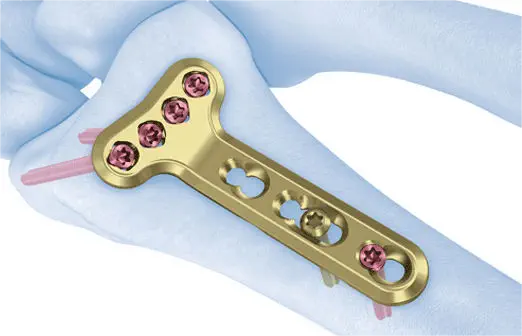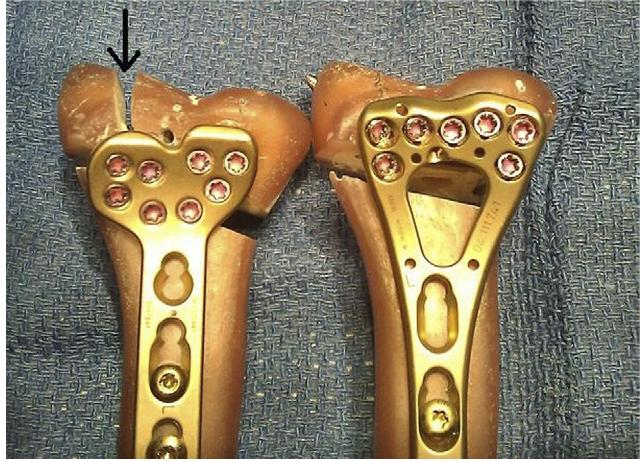Introduction
In the realm of orthopedic surgery, innovations continue to reshape the landscape of fracture treatment. The Distal Volar Radial Locking Plate is a remarkable advancement that has transformed the management of wrist fractures. This article delves into the intricacies of the Distal Volar Radial Locking Plate, its benefits, applications, and why it has garnered considerable attention from both medical professionals and patients.
Unveiling the Distal Volar Radial Locking Plate
The Distal Volar Radial Locking Plate is a specialized implant used to address fractures of the distal radius, a common type of wrist fracture. It is meticulously designed to provide optimal stability and support during the healing process, promoting a quicker and more efficient recovery.

Key Advantages of the Distal Volar Radial Locking Plate
1. Precise Fracture Alignment: The locking plate ensures precise alignment of fracture fragments, reducing the risk of malunion and promoting proper bone healing.
2. Enhanced Stability: Utilizing a locking mechanism, the plate offers enhanced stability by firmly securing the fractured bone fragments, minimizing the chance of displacement.
3. Minimized Soft Tissue Trauma: The surgical procedure involving the Distal Volar Radial Locking Plate requires smaller incisions, resulting in minimal disruption to surrounding soft tissues and reduced post-operative discomfort.
4. Early Mobilization: With improved stability, patients can engage in early mobilization exercises, which are vital for restoring wrist function and preventing joint stiffness.
5. Customizable Fit: The Distal Volar Radial Locking Plate comes in various sizes and configurations, allowing orthopedic surgeons to tailor the treatment to individual patient needs.
Applications of the Distal Volar Radial Locking Plate
Distal Radius Fractures
The primary application of the Distal Volar Radial Locking Plate is in the treatment of distal radius fractures, which account for a significant portion of wrist fractures. Its stability and precise fixation make it a preferred choice for these fractures.
Osteoporotic Fractures
Osteoporotic bones pose unique challenges during fracture treatment. The Distal Volar Radial Locking Plate's robust fixation is particularly beneficial in providing the necessary support for successful healing in osteoporotic conditions.
Fracture Revision Surgery
In cases where a fracture fails to heal correctly or a previous treatment has been unsuccessful, the Distal Volar Radial Locking Plate can be used in revision surgeries to promote proper bone union.
Complex Fracture Patterns
Fractures with complex patterns or multiple fragments can be effectively managed with the Distal Volar Radial Locking Plate, as its stability and fixation capabilities contribute to successful outcomes.

The Surgical Procedure
The surgical implantation of the Distal Volar Radial Locking Plate involves several steps:
1. Patient Evaluation: A comprehensive assessment of the wrist fracture and patient's medical history is conducted to determine the suitability of the locking plate.
2. Anesthesia: The patient receives appropriate anesthesia, either general or regional, to ensure a comfortable procedure.
3. Incision: A small incision is made over the fracture site, allowing the surgeon to access and visualize the fractured bone fragments.
4. Plate Placement: The Distal Volar Radial Locking Plate is positioned precisely over the fracture, and locking screws are inserted to secure the plate in place.
5. Closure: The incision is closed using sutures, and the wrist is dressed with a sterile bandage.
6. Rehabilitation: Following surgery, a tailored rehabilitation program is initiated to aid in wrist recovery and functional restoration.

Conclusion
The Distal Volar Radial Locking Plate stands as a testament to the continuous evolution of orthopedic care. With its precise fixation, enhanced stability, and applicability to various fracture scenarios, it has become a game-changer in wrist fracture treatment. Patients can now anticipate swifter recoveries and improved outcomes, while orthopedic surgeons wield a powerful tool to facilitate optimal bone healing and joint function.
FAQs
Q:Can the Distal Volar Radial Locking Plate be used for other fractures aside from distal radius fractures?
A:While its primary application is in distal radius fractures, the plate's stability and versatility make it a potential option for other complex fractures as well.
Q:How long is the typical recovery period after surgery involving the Distal Volar Radial Locking Plate?
A:Recovery times can vary, but patients often engage in a few weeks of rehabilitation to regain strength and movement in the wrist.
Q:Are there any risks associated with the use of the Distal Volar Radial Locking Plate?
A:As with any surgical procedure, there are potential risks, including infection and implant-related complications. However, the plate's design aims to minimize such risks.
Q:Is removal of the plate necessary after the fracture has healed?
A:In some cases, the plate may be removed once bone healing is complete. Your orthopedic surgeon will determine the best course of action based on individual circumstances.
How to Buy Orthopaedic Implants and Orthopaedic Instruments?
For CZMEDITECH, we have a very complete product line of orthopedic surgery implants and corresponding instruments, the products including spine implants, intramedullary nails, trauma plate, locking plate, cranial-maxillofacial, prosthesis, power tools, external fixators, arthroscopy, veterinary care and their supporting instrument sets.
In addition, we are committed to continuously developing new products and expanding product lines, so as to meet the surgical needs of more doctors and patients, and also make our company more competitive in the whole global orthopedic implants and instruments industry.
We export worldwide, so you can contact us at email address song@orthopedic-china.com for a free quote, or send a message on WhatsApp for a quick response +86-18112515727.
English
Français
Русский
Español
العربية
Português
Deutsch
italiano
日本語
한국어
Nederlands
Tiếng Việt
ไทย
Polski
Türkçe
አማርኛ
ພາສາລາວ
ភាសាខ្មែរ
Bahasa Melayu
ဗမာစာ
தமிழ்
Filipino
Bahasa Indonesia
magyar
Română
Čeština
Монгол
қазақ
Српски
हिन्दी
فارسی
Kiswahili
Slovenčina
Slovenščina
Norsk
Svenska
українська
Ελληνικά
Suomi
Հայերեն
עברית
Latine
Dansk
اردو
Shqip
বাংলা
Hrvatski
Afrikaans
Gaeilge
Eesti keel
Māori
नेपाली
Oʻzbekcha
latviešu
অসমীয়া
Aymara
Azərbaycan dili
Bamanankan
Euskara
Беларуская мова
भोजपुरी
Bosanski
Български
Català
Cebuano
Corsu
ދިވެހި
डोग्रिड ने दी
Esperanto
Eʋegbe
Frysk
Galego
ქართული
guarani
ગુજરાતી
Kreyòl ayisyen
Hausa
ʻŌlelo Hawaiʻi
Hmoob
íslenska
Igbo
Ilocano
Basa Jawa
ಕನ್ನಡ
Kinyarwanda
गोंगेन हें नांव
Krio we dɛn kɔl Krio
Kurdî
Kurdî
Кыргызча
Lingala
Lietuvių
Oluganda
Lëtzebuergesch
Македонски
मैथिली
Malagasy
മലയാളം
Malti
मराठी
ꯃꯦꯇꯥꯏ (ꯃꯅꯤꯄꯨꯔꯤ) ꯴.
Mizo tawng
Chichewa
ଓଡ଼ିଆ
Afaan Oromoo
پښتو
ਪੰਜਾਬੀ
Runasimi
Gagana Samoa
संस्कृत
Gaelo Albannach
Sepeti
Sesotho
chiShona
سنڌي
Soomaali
Basa Sunda
Wikang Tagalog
Тоҷикӣ
Татарча
తెలుగు
ትግንያውያን
Xitsonga
Türkmençe
संस्कृत
ئۇيغۇرچە
Cymraeg
isiXhosa
ייִדיש
Yorùbá
isiZulu













